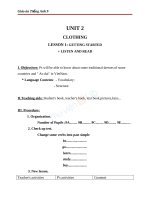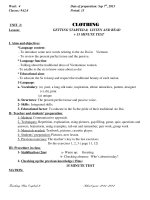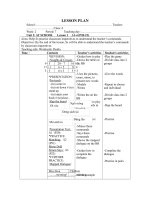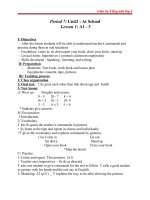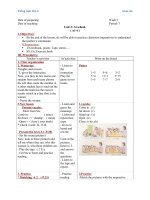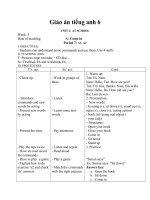Giáo án Tiếng Anh 9 Unit 2: Clothing
Bạn đang xem bản rút gọn của tài liệu. Xem và tải ngay bản đầy đủ của tài liệu tại đây (141.33 KB, 21 trang )
GIÁO ÁN TIẾNG ANH 9
Unit 2: CLOTHING
Lesson 1: Getting started + listen and read
I.The aims of the lesson:
-To help ss to read the text for details.
* Vocabulary: a poet,a long silk tunic,slit,inspiration,take inspiration from
something,ethnic minorities.
*Grammar: -Review passive voice and present perfect.
*Skill: - Main skills:Listening and reading
-Other skills: Speaking and writing
II.The objective of the lesson
-By the end of the lesson, students will be able to know some more about ao dai;
the traditional dress of Vietnamese women.
III.Teaching aids
-Picture, poster
IV.Prodcedure
1.Warm up
( Getting started)
* Matching
-Ask students to match the pictures with suitable countries.
1. Viet Nam 2. Scotland( UK) 3. India
4. US A
5. Arabia 6. Japan
- Get feedback.
- Answers: a-6 ; b- 1 ; c-2 ; d- 3 ; e – 4 ; f- 5
2.Preteach vocabulary
* Active words:
- a poet:
nhà thơ
( examples)
- a long silk tunic
:
áo lụa dài rộng
- (to ) slit:
- inspiration :
xẻ
(translation)
( explanation)
cảm hứng , hứng khởi
- (to) take inspiration from something:
- ethnic minorities :
lấy cảm hứng
các dân tộc thiểu số
(translation)
( examples)
( examples)
* Check : ROR
3.Pre reading
- You are going to read a text about the traditional dress of viet Nam.
- Open prediction
Can you guess :what is the traditional dress of Vietnamese women?.
- Get feedback.
4.While reading
-Asks students to read the text the second time , check their predictions and do
exercise a (page 14)
* Answer: The ao dai
* Passive words: Matching
- century: thỊ kû
- musican: nhạc sĩ
- novel: tiểu thuyết
- traditional: truyền thống
- worn ( wear ): mặc
- loose pants : quần ống rộng
- design :kiểu dáng , thiết kế
- material: vật liệu
- Symbol:biểu tượng
- Unique:độc nhất
- fashionable :hợp thời trang
1…... poems, novels,and songs.
2….. long silk tunic with slits up the sides worn over loose pants
3...... to wear modern clothing at work.
4.......lines of poetry on it .
5...... symbols such as suns, stars , crosses and stripes to the ao dai.
- Ask students to read the text again to answer the questions.( Lucky Number)
* Answers.
1.Traditionally, men and women used to wear the ao dai.
2. Lucky number.
3. Because it is more covenient.
4. Lucky number.
5. They have printed lines of poetry on it or have added symbols such as sun ,
stars, crosses, and stripes to the ao dai.
*Grammar:
It was frequently worn by both men and women.
* Form: S + Be + PII……By + O.
*Practice: Do ex L.F 4 and 5 (write on poster)
5.Post reading
-Rewrite all the answers and ex into the notebooks.
6.Homework assignment
- Translate the text into VNese
- Do exercises I in workbooks.
The end
Unit 2: CLOTHING
Lesson 2: Speak.
I.The aims of the lesson:
-To ask and respond to questions on personal references .
*Skill: -Main skill: Speak
-Other skills: Read,write,listen
II.The objective of the lesson
-By the end of the lesson, students will be able to ask and respond to questions on
personal references.
III.Teaching aids
-Text book,poster.
IV.Procedure
1.Check up
-Write new words.
-Read by heart the summary.
2.Warm up
-What is your favorite clothes?
3.Pre-teach vocabulary
- baggy pants ( n ) : quần thông
( situation)
- (to)fade : bạc màu, phai màu
( example)
- plaid ( adj ) : kẻ ca-rô, kẻ ô vuông
( picture )
- plain ( adj ) : trơn ( không có hoa hay hình vẽ)
( realia )
- sleeveless ( adj ) : không có ống tay ( áo)
( picture)
- stripe (n) : vạch kẻ
( realia )
*Check: Slap the board
4.Pre speaking
- In the last lesson , we got some information about Ao dai – the traditional dress
of Viet Nam. To day we will learn about the casual clothes that we wear daily.
* Matching
- Ask students to look at the pictures and match them with the phrases.
- Get feed back
* Answers:
a-1 ; b-5 ; c-6 ; d-3 ; e-8 ; f-4 ;g-7 ;h-2 ; i-9
* Matching ( poster)
Words
Meaning
1. a colorful T- shirt
a. váy kỴ «
2. a plaid skirt
b. áo phông nhiều màu
3. a plain suit
c. áo sơ mi kẻ sọc
4. a striped shirt
d. bộ quần áo com lê
5. baggy pants
e. aã len cộc tay
6. a sleeveless sweater
f. quần thông
7. blue shorts
g. quần soóc xanh
8. a short- sleeved blouse
h. quần bò mài
9. a faded jeans
i . áo sơ mi ngắn tay
* Answers: 1-b ; 2- a ; 3- d ; 4- c ; 5- f ; 6- e ; 7- g ; 8- i ; 9- h
5.While speaking
-Asks students to work in groups of 8 or 10 students each to read and write two
more questions for the last section of the survey about students ‘ wear.
Questions
1. What do you usually wear on the weekend?
2. Why do you wear these clothes?
3. What is your favorite type of clothing?Why?
4. Is it comfortable to wear uniform ?
Name
Style of clothes
5. What color is it?
6. What type of clothing do you usually wear on
Tet holiday?
7. What would you wear to a party?
6.Post speaking
- Ask students to report the results of their survey.
Ex: - Three people said that they liked their uniform
- Two people said that they usually wore colorful T – shirts on the weekend
- Chi said that she loved baggy pants.
7.Homework assignment
- Do exercises II in workbooks.
- Practice speaking at home.
The end
Unit 2: CLOTHING
Lesson 3: Listen.
I.The aims of the lesson:
-To listen for specific information about an announcement about a lost little girl .
*Skill: -Main skill: Listen
-Other skills: Read,write,speak
II.The objective of the lesson
-By the end of the lesson, students will be able to listen for specific information ,
describe what people are wearing..
III.Teaching aids
-Text book,poster,radio,tape.
IV.Procedure
1.Check up
-Say about his/her favorite clothes.
2.Warm up
Names of clothes and
shoes
3.Preteach vocabulary
- announcement (n) : Thông báo
- missing : thất lạc
= lost
- an entrance = a door ,gate : lối vào
- a fair : hội chợ
- a doll : búp bê
* Check: Slap the board
( translation)
( SYM)
( SYM )
( explanation )
( realia )
4.Pre listening
- T: you will hear an announcement about a lost little girl called Mary.
* Matching
-T: Ask students to look at the pictures and match them with word-cues cards.
- Ss: match
- T:Get feed back
* Answers:
a) A: flower pants
B: blue shorts
C: a white skirt
b)A: long- sleeved white blouse
B: short- sleeved pink shirt
C: short- sleeved white shirt
c) A: sandals
B: boots
C: brown shoes
5.While listening
Sts listen twice & choose the correct answers about what Mary wears
a/B
b/A
c/C
.-T: Asks students to listen once more and check (v )the letter of the correct picture
to show what Mary is wearing.
-Ss: Listen
-T:Gets feedback
* Answers: a) B- She is wearing blue shorts
b) A: She is wearing a long- sleeved blouse
c) C: She is wearing brown shoes.
T:-Asks students to listen and answer the questions:
.1. How old is she? – She is three
2. Where was she last seen?- She was last seen near the main entrance to the Car
Fair
3. What’s she like?
- She has short dark hair.
6.Post listening
Sts work in groups of 6 to describe about Mary in 8 ms,beginning with:
Mary is a lost little girl.She is 3 years old,she is wearing..........
Get feed back &correct.
7.Homework assignment
- T: Ask students to rewrite the writing and do exercises 1,2 in workbooks.
The end
Unit 2: CLOTHING
Lesson 4: Read.
I.The aims of the lesson:
-To help ss read the text for details about the development of Jeans.
*Skill: -Main skill: Read
-Other skills: Listen,write,speak
II.The objective of the lesson
-By the end of the lesson,students will be able to understand the text for details
about jeans.
III.Teaching aids
-Text book,poster.
IV.Procedure
1.Check up
-Read by heart the sumary of the listening.
2.Warm up
* Hang man( check vocabulary) –Jeans
3.Pre teach vocabulary
* Active words:
- material (n ) : chất liệu
(example)
- cotton : bông, sợi bông
(translation)
- (to) wear out : làm rách
(mime)
- (a) style : kiểu dáng
( explanation)
- (to) embroider (v) : thêu( hoa văn, hình)
( realia)
- (a) label : nhãn, nhãn hiệu
( realia)
* Passive words: - Matching
Words
Meaning
- sailor
nhà thiết kế
- designer
thủ thủ
- fashion
số lượng bán ra
- sale
thời trang
- economic
lỗi thời lỗi mốt
- out of fashion
kinh tế
4.Pre reading
T :-To day we are going to learn more about the history of jeans and it’s
conveniences.
T/F statements prediction
1. The word ‘’Jeans ‘’ comes from Asia.
2. In the 18th century worker didn’t love wearing jeans.
3. In the 1960s, many university and college students wore jeans.
4 In the 1970s ,more people started wearing jeans because they became more
expensive.
5. In the 1980s, sales of jeans went up and up.
6. In the 1990s , the sale of jeans stopped growing.
T: -Asks Ss to read the text and guess the sentence which is True or which is
False.
Ss: Guess
-T: - Get feedback. 1 . T/F
2.T/F
3.F/T
4. F/T
5.T/F
5.While reading
- T: -Asks students to read the text and check their guesses.
- T: corrects.
1. F
- The word “Jeans “ comes from Europe.
2. F
- Because the worker loved wearing jeans in the 18th century.
3. T
4. F
- because they became cheaper.
5. T
6. T
T:- Ask students to read the text to fill in the missing dates and words, exercises a)
on page 17.
Ss: - Read the text and fill in the missing dates and words on exercises a.
* Answers.
1. 18th century – jean cloth
2.1960s – students
3. 1970s - cheaper
4. 1980s - fashion
5. 1990s - sale
- Game: Lucky Numbers
1. Where does the word “ jeans” come from?
(- The word jeans comes from a kind of material that was made in Europe.)
2. What were the 1960s’ fashions ?
( - The 1960s’ fashions were embroidered jeans and painted jeans.)
3. Why did more and more people begin wearing jeans in the 1970s ?
( - .....because jeans became cheaper.)
4. Lucky number.
5. When did jeans at last become high fashion clothing ?
(- Jeans at last became high fashion clothing in the 1980s.)
6. Why did the sale of jeans stop growing?
( -... because the worldwide economic situation got worse in the 1990s.)
6.Post reading
Ask Ss to rewrite all the answers into the notebooks.
-Work in group of 4,retell the development of jeans(depend on the qs above)
7.Homework assignment
- Translate the text into VNese
- Do exercises III in workbooks.
The end
Unit 2: clothing
Lesson 5: Write
I/The aims of the lesson: To help students write an exposition.
*Skills:
-Main skill: Writing.
-Other skills: Listening , speaking, reading
II/The objective of the lesson:
By the end of the lesson, students will be able to write an exposition, one
presenting side of an argument.
III/Teaching aids:
-Text book,posters.
IV/Procedures:
1/Check up:
Speaking:T ask a st some qs about the reading last period &give mark.
2/ Warm up: Chatting:
Do you like wearing uniform at school?Why?
3/.Pre-teach voc:
- ( to) encourage: khuyến khích ,động viên
( explanation)
- (to) be equal in : công bằng , bằng nhau
( situation)
- (to) bear one’s name : mang tên
( translation)
- freedom of choice : tự do lựa chọn
( translation)
- self- confident (adj) : tự tin
( situation)
* check; ROR
4/.Pre-writing : * Matching
.
A
B
Introduction
presents arguments in a logical way
C
Firstly,...
( one in each paragraph ),
Secondly,...
gives examples where possible
Series of
Finally,...
lets the reader know the writer’s
Therefore,...
arguments
point of view
In
conclusion,...
Conclusion
sums up the argument
My opinion
is,...
I think,...
T:
-Ask students to answer these questions:
Ss: - Answer these questions
1. What do you write in “ introduction”?
- Lets the reader know the write’s point of view.
2. What language is used in “ introduction” ?
- My opinion is..... /I think.....
3. How can we present series of an arguments?
- Presents arguments in a logical way( one in each paragraph) gives examples
where possible.
4. What language is used in series of arguments ?
- Firstly,.../ Secondly,.../Finally,...
5. What do you write in conclusion ?
- To sum up the argument
6. What language is used in conclusion?
- Therefore,.../ In conclusion,...
5/While-writing
T: - Ask students to read the topic and outlineA.
Ss: - Read the topic and outline A.
T: - Ask some comprehension questions
Ss: - Answer the questions
*. What is the topic of the passage?
- ...wearing uniforms.
*. Why does wearing uniforms encourge students to be proud of their school ?
- Because the uniforms bear their school’s name.
*. How do students feel when wearing uniforms?
- They feel equal in many ways.
* Do students have to think of what to wear every day ?
- No.
- Ask students to read outline B and use it to write a paragraph of 100- 150 words
to support the argument that secondary school students should wear casual clothes.
Suggested passage.
My opinion is that secondary school students should wear casual clothes.
Firstly, casual clothes make students feel cofortable because they don’t feel
compulsory to wear uniforms that they don’t like.
Secondly, wearing casual clothes gives students freedom of choice. They can
choose sizes, colors and fashion that they love. Wearing casual clothes makes
students feel self- confident when they are in their favorite clothes
Finally, casual clothes make school more colorful and lively.
In conclusion, students in secondary schools should wear casual clothes.
6/Post-writing:
- T: Ask students to share compare with their partners.
- Ss: Share compare
- T: - Ask students to read out their writings and teacher corrects their
mistakes.
- Ss: - Read out their wrirings.
7/Homework assignment:
- T: - Ask students to write their letters ( after correction) on their notekooks.
and do exercises in workbooks.
The end
Unit 2: clothing
Lesson 6: Language Focus
I/The aims of the lesson:
To help sts review present perfect,passive voice.
* Vocabulary: Review
*Grammar: Practice ALREADY and YET in the present perfect tense, distinguish
the difference in using the past simple and the present perfect tense.
- Review the passive forms of the present perfect, simple present, simple past, and
simple future.
- Practice passive modal verbs.
* Skills: - Main skills: Speaking and writing
-Other skills: Listening and reading
II./The objective of the lesson:
-By the end of the lesson,students will be able to know how to use the present
perfect tense and the passive & do exercises perfectly and correctly.
III/Teaching aids:
-Word-cues cards, posters
IV/Procedures:
1. Review:
- Remind the students the form of the present perfect tense, and the passive.
* The form of Present perfect :
S + have / has + Ved ( V P II ) ...
* The form of Passive : Be + Ved ( V P II )
2. Warm up:
* Chatting
3 Pre- teach vocabulary. * Pelmanism
visit – visited
see- seen
eat - eaten
use-used
go – gone
play - played
4.Presentation.
Presentation 1:
* Model: A: Have you seen Giac Lam Pagoda yet?
B: Yes, I’ve already seen it./ No, I haven’t seen it yet
• Check : - Meaning: ALREADY: rồi, đã rồi
YET : chưa
- Use: ALREADY is uesd in affirmative sentences
( position: midsentence)
YET is used in negative sentences and questions
( position : end of the sentence)
Presentation 2: *Model :
A: Have you ever read comic?
B: Yes, I have/ No, I haven’t
* Check : Meaning : đã bao giờ
Use : EVER is used in questions
5.Controlled Practice:.
L.F 2:
T: – Ask students to work in pair. Ask and answer questions about the things you
have done. Use the present perfect tense of the verbs in the box.
* Example: A: Have you seen Gia Lam Pagoda yet?
B: Yes, I’ve already seen it.
A: Have you eaten Vietnamese food yet?
B: No, I haven’t.
Ss: Work in pairs
L.F 3: * Matching
.
Verbs
Nouns
read
volleyball
play
comic
see
computer
use
elephant/ movie
go
durian
eat
Hue / supermarket
- T : -Ask students to work in pairs to ask and answer questions about each of
items in the box.
• Example: A: Have you ever read a comic?
B : Yes, I have.
A : When did you last read one?
B : This morning
A : Have you ever been to Singapore ?
B : No, I haven’t.
Ss: Work in pairs
T: -Ask students to use the passive to change the sentences in exercise 4 and
exercise 5 at page 21
Ss: Do exercises
* Answers: E4:
a) Jeans cloth was made completely from cotton in the 18th century.
b) Rice is grown in tropical countries.
c) Five million bottles of champagne will be produced in France next year.
d) A new style of jeans has just been introduced in the USA.
e) Two department stores have been built this year.
E5: a) The problem can be solved.
b) Experiments on animals should be stopped
c) Life might be found on another planet.
d) All the schools in the city have to improved
e) A new bridge is going to be built in the area.
- Teacher corrects mistakes.
6/Production:
- Ss: rewrite E4 and E5 into their notebooks
7/Homework assignment:
T asks Ss to finish their writings and do the last exercises in workbooks.
